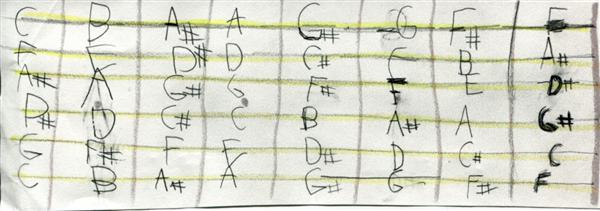Our main assignment this week is to work on playing louder. Although our teacher asked us to work on this with three review songs, in today’s practice we only got to one: French Folk Song. And even though we practiced for about an hour, we didn’t practice anything else.
We began as M’s studio teacher suggested, using a mute under the strings (rolled up non-skid padding) to force the issue of loudness — with the mute, to be heard at all, you have to play forcefully.
While I agree that M needs to play louder — to press down on the strings, rather than just brushing over them — I’m worried about creating tension in her right hand. For one thing, right-hand tension has already been an issue for her in the past. For another, I happened to have just finished reading Glenn Kurtz’s charming memoir Practicing: A Musician’s Return to Music, in which a crucial event is Kurtz’s discovery when he arrives at the New England Conservatory to study guitar that this very technique created habits he had to unlearn. Kurtz writes (p. 58):
[W]en I was a child, I’d taken technique classes to build strength. . . . We put a dustcloth under the strings just behind the sound hole to mute the instrument. . . . The cloth mute made the strings less pliable. Increasing resistance, we were taught, strengthened our fingers.
Strong fingers were good, and mine were among the strongest. . . . Now, at the Conservatory, [my teacher] showed me how my strength worked against itself.
“You’re bullying the strings,” he said at a lesson a few weeks later. “Use the least possible force, the least effort.”
Alone in a practice room I returned to basic technique to see more clearly how I had always played. What I saw horrified me. With each fingerstroke I tensed my forearm or shoulders or neck or palm or wrist. Training for strength, it seemed, was a terrible way to teach technique. It had taught me to work too hard. The tension in my arms was just a substitute for a cloth mute, an unconscious attempt to reproduce the resistance my fingers had been taught to expect. Worse still, the mute had prevented the strings from vibrating, teaching me to play the strings without playing notes. I’d learned to focus on the finger, not on the sound.
So I had three goals for M today:
- to play louder,
- without extra tension, and
- while listening to herself.
I had her spend a lot of time just playing open Gs. I noticed her hand rotating from side to side — i.e., instead of placing her fingers straight down, she was rotating so that i and m were placed far apart — so we played “fix me”: I did what she had been doing and (after much work) got her to see when I was doing it.
When we got to French Folk Song, she played it with no dynamic contrast. She was aware of this after the fact, but had a hard time doing anything about it. And she typically started the song (or an individual section) with good downward pressure, but quickly reverted to brushing the strings, and it didn’t seem like she ever noticed the change. I asked her to play just the B section several times with her eyes closed and listen to whether her tone changed, but she couldn’t reliably tell me anything about her sound.
We did do one modestly successful awareness exercise. Each section ends with a dotted half note, and that note’s duration provides time to think about what’s coming. Two sections (C and D) should start quiet and crescendo, and M was not playing this way. So I asked her to let treat each dotted half note as if it had a fermata, and let it ring until she could no longer hear it. Only when it stopped ringing should she start the next section, and she should start quiet if she’s on the C or D sections. With this instruction, she did manage to play the crescendos at least one time through.
On the behavior front, this wasn’t our best lesson — she was very fidgety and didn’t take direction as well as I’d like. I got to the point of saying that if we couldn’t achieve what I wanted to achieve in the time I had set aside for practice, she wasn’t going to be able to go to a play that we had planned to go to. In a way, this is a natural consequence — if you have a job to do and can’t do it in the allotted time, that screws up your schedule and you may have to change plans — but it functioned more like a threat. I don’t like making threats, but I’m still not skillful enough to always refrain from them.
